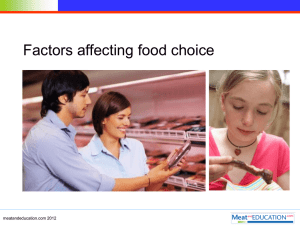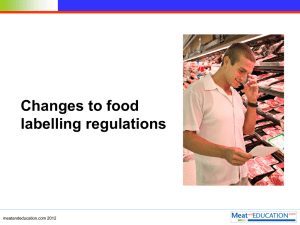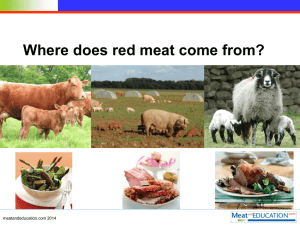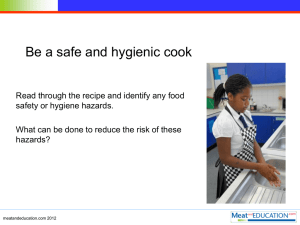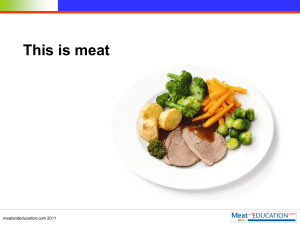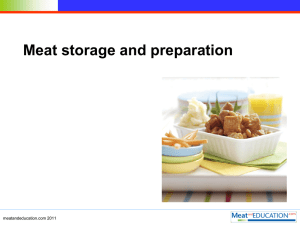5.2 MB - Meat and Education
advertisement
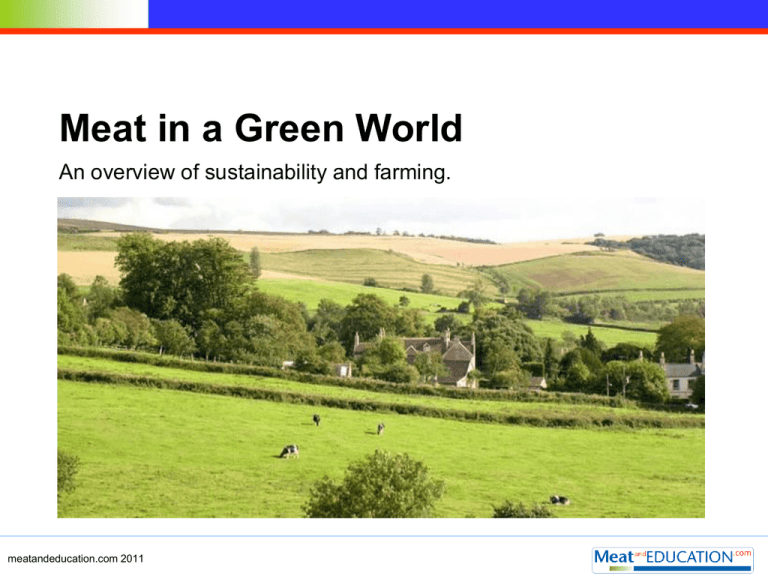
Meat in a Green World An overview of sustainability and farming. meatandeducation.com 2011 Welcome Use the following buttons to guide you through this resource. This button takes you to the main menu. This button moves you to the next slide. This button moves you to the previous slide. meatandeducation.com 2011 Menu Click on the information section you wish to read. Click Questions, if you are ready to take the multiple choice quiz. Information 1. Overview of Climate Change 2. Causes 3. The Consequences of Global Warming 4. Sustainable Development 5. Overview of Livestock Farming Questions meatandeducation.com 2011 6. The Challenge for Livestock Farmers 7. How are Emissions Measured? 8. Reducing GHG Emissions from Livestock Farming 9. Improvement Strategy 10. Changing Consumers’ Behaviour End 1. Overview of Climate Change The ‘greenhouse’ effect is essential to life on earth. Greenhouse gases (GHGs) naturally make up about 1% of the earth’s atmosphere and help to regulate our climate. However, as a result of population growth and industrial development, human activity is responsible for releasing more GHGs into the atmosphere than would normally occur. This has affected the natural regulation of the earth’s temperature resulting in increased climate change that is unpredictable with variations and extremes of temperature and weather conditions. meatandeducation.com 2011 2. Causes Globally many human activities are responsible for GHG emissions: energy production and usage, transport, industry, agriculture and forestry. Food production is responsible for around a fifth of the UK’s greenhouse gas emissions, of this figure a third comes from agriculture and land use. The other two thirds from processing, retailing and consumer use of food and food waste (Pigs and The Environment, A Kleanthous 2009). meatandeducation.com 2011 2. Causes The majority of GHG emissions are in the form of carbon dioxide (CO2) from fossil fuel use and deforestation (the destruction of forests that help trap CO2 and replenish oxygen in the atmosphere), but methane (CH4) and nitrous oxide (N2O) from agriculture also make a significant contribution. The global warming potential (GWP) of Methane and Nitrous oxide are much higher per tonne than that of Carbon Dioxide, although the effects may not last as long in the atmosphere. Methane 21 x greater Global Warming Potential than CO2 (over 100 years) Nitrous oxide 296 x greater Global Warming Potential than CO2 (over 100 years) meatandeducation.com 2011 3. The Consequences of Global Warming “Climate is what you expect, weather is what we get.” (Mark Twain) There is evidence that the climate is changing, but the big question is whether this a natural event or driven by human behaviour. The impact of changing climate is complex with variability in different regions at different times. Variable weather patterns should not be confused with long term trends which take over 30 years to track and record. It is thought that long term effects of climate change are likely to be: increased areas affected by drought; increased intense tropical cyclones; increased incidence of high sea levels; melting of polar ice caps; warming of oceans. meatandeducation.com 2011 4. Sustainable Development Currently, our consumption of natural resources is faster than the rate at which they can be created or replaced. No production system can be sustained in the long term if it exceeds the Earth's overall ability to process waste and provide for a stable climate, flood regulation, pollination and many other essential environmental services. There are many definitions of sustainable development. The most widely used is: “Meeting the needs of the present generation without compromising the ability of future generations to meet their needs” (Brundtland Commission's 1987 report for the United Nations, Our Common Future). meatandeducation.com 2011 4. Sustainable Development Achieving sustainable development requires a balance between expanding economic opportunity, reducing hunger and poverty, whilst preserving the planet. “ Improving life while living within the capacity of the ecosystem” (World Wildlife Fund 1991). meatandeducation.com 2011 5. Overview of Livestock Farming Introduction Livestock farming in the UK is a large, complex and highlyinterdependent industry. 2.9 million cattle, 16.7 million sheep and 9.2 million pigs supply the human food chain with a nutrient dense product that has been at the heart of the national diet for thousands of years. But we do not produce all we eat, imports are a significant part of the market, such as for pig meat where we are only 48.0% self sufficient. meatandeducation.com 2011 5. Overview of Livestock Farming More than 60% of British agricultural land is grassland and much of it is unsuitable for crop production. There are large areas of the UK which cannot reasonably produce food for people unless cattle or sheep are grazed. Livestock farming plays an important part in landscape management. The traditional small hedge-bounded field structure that characterises English hills and uplands is maintained by grazing livestock. meatandeducation.com 2011 5. Overview of Livestock Farming Furthermore, rough grazing plays an important role in locking up carbon dioxide in plant material and soil organic matter and regulating the flow of rain into water courses. Without livestock farming the landscape could look very different. meatandeducation.com 2011 6. The Challenge for Livestock Farmers To meet the carbon targets made legally binding in the 2008 Climate Change Act, the Government has published the UK Low Carbon Transition Plan. This sets out a comprehensive strategy to reduce national GHG emissions by 18% of estimated 2008 levels by 2020. As part of this plan, English farmers are required to continue making reductions in their annual GHG emissions. The immediate priority is for emissions estimated in 1990 to be at least 11% lower than the level predicted for 2020 – a saving of some 3 million tonnes per year of CO2. meatandeducation.com 2011 6. The Challenge for Livestock Farmers The global warming potential (GWP) for meat is the sum of methane emissions from rumen fermentation and manure breakdown, nitrous oxide from the fertilisers used to grow feed and carbon dioxide emitted from transport, processing, packaging, and cooking the end product. The GWP per tonne produced is 6 for pig meat, compared with 16 for beef, 17 for lamb and 5 for poultry. meatandeducation.com 2011 7. How are Emissions Measured? Calculating the level of GHG emissions produced by livestock farming is a complex task. The tool adopted by experts is called Life Cycle Analysis (LCA). LCA is a method of accurately assessing the burden placed on the environment by the production or manufacture of a product. The analysis takes into account how much energy and raw materials are used and the amount of products and waste generated at each stage of a product’s life. For example, for pigs this might include: > On farm : source and type of feed, housing, manure storage > Abattoir/Meat plant : transport, use of energy and water in the plant, meat waste, refrigeration > Retailer: transport, packaging, refrigeration > Consumer: transport, refrigeration, cooking, waste disposal meatandeducation.com 2011 7. How are Emissions Measured? The following measures are used to make comparisons of the impact: Global warming potential – greenhouse effect caused by emissions of greenhouse gases Eutrophication – oxygen depletion of water and reduction in water quality due to increased nitrates, phosphates and ammonia in the ecosystem as a result of chemical fertiliser use. Acidification – emissions causing extremes of pH in habitats e.g. acid rain Abiotics – depletion of natural resources that cannot be preplaced for example fossil fuels. meatandeducation.com 2011 7. How are emissions measured? These are quantified and used to identify possible improvements or changes in production patterns or methods. LCA is a rapidly developing science and methodologies often do not compare like with like. By considering all the individual components, experts have been able to establish national benchmarks for primary energy consumption and overall GHG emissions for food production. meatandeducation.com 2011 8. Reducing GHG Emissions from Livestock Farming Achieving Targets To play their part in ensuring that British farming meets its UK Carbon Reduction Plan target, farmers must continue to reduce their annual GHG emissions by at least 11% from 1990 levels by 2020. The industry works on the measurement of emissions per kilogramme of meat as the benchmark for efficiency. Reductions in stock numbers would, if consumption stays the same, cause the transfer of production, and therefore emissions, to other parts of the world. meatandeducation.com 2011 8. Reducing GHG Emissions from Livestock Farming Over recent years profitability through efficiency has led to a decline in livestock numbers, which has led to a decrease of GHG emissions of 17% since 1990. However, with a growing population output needs to be increased to meet world food needs. The ongoing challenge of reducing emissions and providing sufficient meat for consumption will be met by further improvements to productivity. However, the United Kingdom is not totally self sufficient in meat production and imports play a major part in fulfilling demand. meatandeducation.com 2011 We also export parts of the carcase which other nations prefer consuming. This helps maximise carcase ultilisation and therefore reduces the GHG per unit of meat. 9. Improvement Strategy Within the beef, sheep and pig industries, the following areas have been identified as opportunities for efficiency and improvement. Select better animals Genetic selection can improve growth rates in pigs, cattle and sheep with subsequent increase in yield of meat. Improvement of reproductive performance will reduce the numbers of breeding animals required and in addition increase the number of live healthy offspring. meatandeducation.com 2011 9. Improvement Strategy In the pig industry genetic characteristics are also important for the efficient conversion of feed into meat muscle (feed conversion ratio) and increasing prolificacy i.e. the number of animals born and reared per sow. Similarly, disease resistance and longevity of life are all ‘heritable’. These genetic traits are key to efficiency; however, efficient production must not be at the expense of high animal welfare. meatandeducation.com 2011 9. Improvement Strategy Change the feed Improving the formulation of rations fed to livestock can impact upon the level of emissions. Matching the energy and protein needs of the animal to the diet in beef cattle rations encourages lower methane production per kg of beef produced. New forage crops are being developed that offer a better nutrient balance to livestock for example high sugar ryegrasses for cattle and sheep. meatandeducation.com 2011 9. Improvement Strategy Soya is an important source of protein for farmed livestock in the UK. Inclusion rates in the diet range from 30% for chickens, 10% for pigs and 3% for ruminants. Much of the soymeal used is imported from North and South America. The Round Table on Responsible Soy (supported by WWF) is an international platform to support the production of sustainable, ethically produced soya. A number of livestock stakeholders have agreed to encourage increased use of sustainable soya. The pig industry is currently undertaking research to replace soya in the diet of pigs. meatandeducation.com 2011 9. Improvement Strategy Fertiliser and Waste management Over the past 10 years, the overall nitrogen, phosphate and potash applications to grassland in England and Wales have been halved. In terms of agricultural practice in the UK, beef and sheep farmers are the lowest users of artificial fertilisers on grass. Urine and faeces from livestock contain useful nutrients for use by grass and crops. Farmers use manures from housed animals to grow crops. If the grass or crop does not capture and use all of the nitrogen in the manure or urine deposited by the animals in the field this surplus can be leached out by rainwater as it travels through the soil to streams and lakes or underground reservoirs. Surplus nitrogen form manures or fertilisers remaining in the soil during winter may from nitrous oxide a very potent greenhouse gas. There are some chemicals, called denitrification inhibitors which can be used on land to reduce the problem, but they are currently too expensive for widespread use. meatandeducation.com 2011 9. Improvement Strategy Ammonia is an issue with all housed livestock, but modern housing and feeding management can reduce the impact on the environment. Covering a slurry store reduces the emissions of ammonia and methane into the atmosphere. meatandeducation.com 2011 9. Improvement Strategy Use of anaerobic digesters, whilst not widespread, will manage a naturally occurring process through the conversion of methane into bio-gas energy and produce high volumes of fertiliser as a byproduct which can be used as a replacement to chemical fertilisers. As well as managing methane and carbon dioxide emissions from livestock production, anaerobic digestors can save money by potentially providing the farmer with energy, fuel and sustainable fertiliser. The energy maybe in the form of heat or electricity, or both. meatandeducation.com 2011 9. Improvement Strategy Pollutants from livestock farming can be reduced but not eradicated. More research is required to help farmers manage the waste that is an inevitable by-product of livestock production. Sustainable production is the sum of the parts: genetics, feed , housing, technology adoption, systems management ( including slurry management) and acquisition of knowledge on the part of all individuals involved in livestock production. meatandeducation.com 2011 10. Changing Consumers' Behaviour Human Diet and Health A healthy balanced diet is vital to our well being. Meat contains a range of beneficial nutrients some of which are more freely available than from a vegetarian diet. Some meat and meat products, however, can contain high levels of saturated fat, associated with heart disease and diabetes. meatandeducation.com 2011 10. Changing Consumers' Behaviour The average consumption of red meat in this country is around 76g per day – a moderate amount. The majority of people in Great Britain consume a very varied and cosmopolitan diet which will not necessarily include red meat every day. Consumers whose diet is more reliant on processed meat products, which by their very nature will involve greater contribution to GHGs, should be encouraged to choose fresh lean red meat instead. meatandeducation.com 2011 10. Changing Consumers' Behaviour Waste UK households throw away 6.6 million tonnes of food waste every year. Of this, nearly a fifth – 4.1 million tonnes – could have been eaten if it had been stored or managed better. Families with children create the greatest proportion of avoidable food waste. Fresh, rapidly perishable foods such as bread, salad, and fruit tend to be wasted in a higher proportion than meat. This may be because of the relative expense of meat. meatandeducation.com 2011 10. Changing Consumers' Behaviour WRAP has a target to reduce consumer food waste by 100,000 tonnes by April 2011. More than 30 retailers have signed up to this commitment. Reducing the amount of packaging used for food is not the only consideration for sustainability. Innovative packaging technologies such as gas flushing, interactive films, re-sealable packages can all increase shelf life and therefore food waste. For unavoidable food waste WRAP recommends home composting or the use of local authority recycling. meatandeducation.com 2011 Questions Welcome to the question section. You will be given 10 questions to complete. Each question is multiple choice. Click on the answer you believe is correct. Click the arrow to start the questions. meatandeducation.com 2011 Question 1 What is the greatest source of greenhouse gas emissions in the UK ? 1. Farming and food production 2. Fossil fuel use and deforestation 3. Nuclear fuel use and deforestation 4. Car fuel use and food production meatandeducation.com 2011 Question 1 Correct, well done. Click the arrow to go to the next question. meatandeducation.com 2011 Question 1 Incorrect, try again. Click this arrow to go to try the question again. Click this arrow to go to try the next question. meatandeducation.com 2011 Question 2 How much is food production responsible for the UK’s greenhouse gas emission? 1. One-third 2. Two-thirds 3. One-fifth 4. One-sixth meatandeducation.com 2011 Question 2 Correct, well done. Click the arrow to go to the next question. meatandeducation.com 2011 Question 2 Incorrect, try again. Click this arrow to go to try the question again. Click this arrow to go to try the next question. meatandeducation.com 2011 Question 3 Name three main consequences of global warming. 1. Drought, disease and pest infestation. 2. Deforestation, more ice caps and rain. 3. Low sea levels, melting polar ice and disease. 4. Drought, melting ice caps and warming oceans. meatandeducation.com 2011 Question 3 Correct, well done. Click the arrow to go to the next question. meatandeducation.com 2011 Question 3 Incorrect, try again. Click this arrow to go to try the question again. Click this arrow to go to try the next question. meatandeducation.com 2011 Question 4 What is the percentage of pig meat which the UK produces for its own needs? 1. 38% 2. 48% 3. 58% 4. 83% meatandeducation.com 2011 Question 4 Correct, well done. Click the arrow to go to the next question. meatandeducation.com 2011 Question 4 Incorrect, try again. Click this arrow to go to try the question again. Click this arrow to go to try the next question. meatandeducation.com 2011 Question 5 Which of the following is locked-up in plant material as a result of rough grazing? 1. Methane 2. Carbon dioxide 3. Nitrogen 4. Nitrous oxide meatandeducation.com 2011 Question 5 Correct, well done. Click the arrow to go to the next question. meatandeducation.com 2011 Question 5 Incorrect, try again. Click this arrow to go to try the question again. Click this arrow to go to try the next question. meatandeducation.com 2011 Question 6 What reduction in GHG emissions are English farmers required to make? 1. 5% lower than in 1990 by 2020 2. 11% lower than in 1990 by 2020 3. 21% lower than in 1990 by 2020 4. 31% lower than in 1990 by 2020 meatandeducation.com 2011 Question 6 Correct, well done. Click the arrow to go to the next question. meatandeducation.com 2011 Question 6 Incorrect, try again. Click this arrow to go to try the question again. Click this arrow to go to try the next question. meatandeducation.com 2011 Question 7 For a product, Life Cycle Analysis (LCA) takes into account: 1. The amount of energy used, recycling potential and waste produced. 2. The amount of transport and materials used, as well as recycling. 3. The amount of energy and raw materials used, as well as waste generated. 4. The amount of energy and money used, as well as waste recycled. meatandeducation.com 2011 Question 7 Correct, well done. Click the arrow to go to the next question. meatandeducation.com 2011 Question 7 Incorrect, try again. Click this arrow to go to try the question again. Click this arrow to go to try the next question. meatandeducation.com 2011 Question 8 Name three improvement strategies for meat production. 1. Animal selection, feed change and waste management. 2. Animal selection, increased roaming and water management. 3. Waste selection, change in animal type and waste management. 4. Land selection, increased methane production and water use. meatandeducation.com 2011 Question 8 Correct, well done. Click the arrow to go to the next question. meatandeducation.com 2011 Question 8 Incorrect, try again. Click this arrow to go to try the question again. Click this arrow to go to try the next question. meatandeducation.com 2011 Question 9 What is the average amount of red meat consumption in Great Britain? 1. 176g per day 2. 136g per day 3. 106g per day 4. 76g per day meatandeducation.com 2011 Question 9 Correct, well done. Click the arrow to go to the next question. meatandeducation.com 2011 Question 9 Incorrect, try again. Click this arrow to go to try the question again. Click this arrow to go to try the next question. meatandeducation.com 2011 Question 10 Which type of household creates the biggest proportion of food waste? 1. Singles 2. Families with children 3. Retired couples 4. Young couples meatandeducation.com 2011 Question 10 Correct, well done. Click the arrow to go to the next question. meatandeducation.com 2011 Question 10 Incorrect, try again. Click this arrow to go to try the question again. Click this arrow to end. meatandeducation.com 2011 End of questions. Click the home button to return to the main menu. meatandeducation.com 2011 Thank you for using Meat in a Green World. For further information and support, go to: www.meatandeducation.com meatandeducation.com 2011
